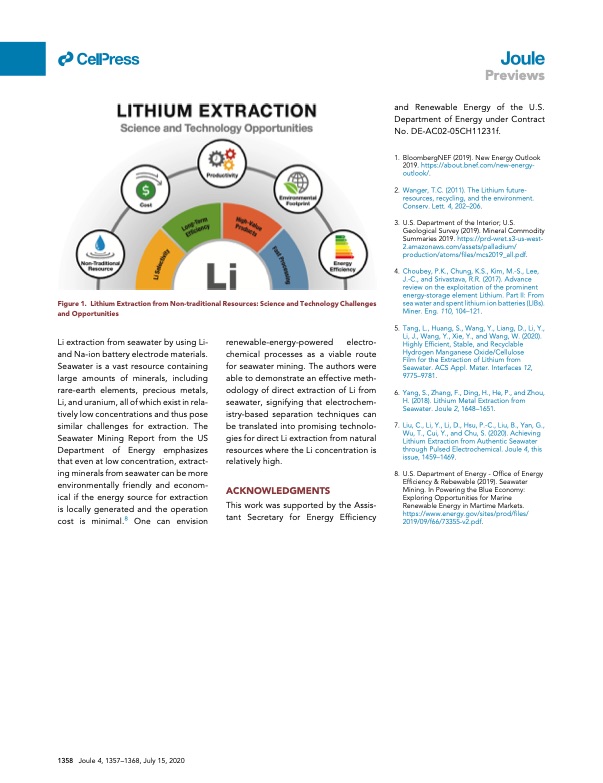
PDF Publication Title:
Text from PDF Page: 002
ll Figure 1. and Opportunities Li extraction from seawater by using Li- and Na-ion battery electrode materials. Seawater is a vast resource containing large amounts of minerals, including rare-earth elements, precious metals, Li, and uranium, all of which exist in rela- tively low concentrations and thus pose similar challenges for extraction. The Seawater Mining Report from the US Department of Energy emphasizes that even at low concentration, extract- ing minerals from seawater can be more environmentally friendly and econom- ical if the energy source for extraction is locally generated and the operation 8 Previews and Renewable Energy of the U.S. Department of Energy under Contract No. DE-AC02-05CH11231f. 1. BloombergNEF (2019). New Energy Outlook 2019. https://about.bnef.com/new-energy- outlook/. 2. Wanger, T.C. (2011). The Lithium future- resources, recycling, and the environment. Conserv. Lett. 4, 202–206. 3. U.S. Department of the Interior; U.S. Geological Survey (2019). Mineral Commodity Summaries 2019. https://prd-wret.s3-us-west- 2.amazonaws.com/assets/palladium/ production/atoms/files/mcs2019_all.pdf. 4. Choubey, P.K., Chung, K.S., Kim, M.-S., Lee, J.-C., and Srivastava, R.R. (2017). Advance review on the exploitation of the prominent energy-storage element Lithium. Part II: From sea water and spent lithium ion batteries (LIBs). Miner. Eng. 110, 104–121. 5. Tang, L., Huang, S., Wang, Y., Liang, D., Li, Y., Li, J., Wang, Y., Xie, Y., and Wang, W. (2020). Highly Efficient, Stable, and Recyclable Hydrogen Manganese Oxide/Cellulose Film for the Extraction of Lithium from Seawater. ACS Appl. Mater. Interfaces 12, 9775–9781. 6. Yang, S., Zhang, F., Ding, H., He, P., and Zhou, H. (2018). Lithium Metal Extraction from Seawater. Joule 2, 1648–1651. 7. Liu, C., Li, Y., Li, D., Hsu, P.-C., Liu, B., Yan, G., Wu, T., Cui, Y., and Chu, S. (2020). Achieving Lithium Extraction from Authentic Seawater through Pulsed Electrochemical. Joule 4, this issue, 1459–1469. 8. U.S. Department of Energy - Office of Energy Efficiency & Rebewable (2019). Seawater Mining. In Powering the Blue Economy: Exploring Opportunities for Marine Renewable Energy in Martime Markets. https://www.energy.gov/sites/prod/files/ 2019/09/f66/73355-v2.pdf. Lithium Extraction from Non-traditional Resources: Science and Technology Challenges cost is minimal. One can envision renewable-energy-powered electro- chemical processes as a viable route for seawater mining. The authors were able to demonstrate an effective meth- odology of direct extraction of Li from seawater, signifying that electrochem- istry-based separation techniques can be translated into promising technolo- gies for direct Li extraction from natural resources where the Li concentration is relatively high. ACKNOWLEDGMENTS This work was supported by the Assis- tant Secretary for Energy Efficiency 1358 Joule 4, 1357–1368, July 15, 2020PDF Image | Mining Lithium from Seawater

PDF Search Title:
Mining Lithium from SeawaterOriginal File Name Searched:
mining-lithium-from-seawater.pdfDIY PDF Search: Google It | Yahoo | Bing
Product and Development Focus for Salgenx
Redox Flow Battery Technology: With the advent of the new USA tax credits for producing and selling batteries ($35/kW) we are focussing on a simple flow battery using shipping containers as the modular electrolyte storage units with tax credits up to $140,000 per system. Our main focus is on the salt battery. This battery can be used for both thermal and electrical storage applications. We call it the Cogeneration Battery or Cogen Battery. One project is converting salt (brine) based water conditioners to simultaneously produce power. In addition, there are many opportunities to extract Lithium from brine (salt lakes, groundwater, and producer water).Salt water or brine are huge sources for lithium. Most of the worlds lithium is acquired from a brine source. It's even in seawater in a low concentration. Brine is also a byproduct of huge powerplants, which can now use that as an electrolyte and a huge flow battery (which allows storage at the source).We welcome any business and equipment inquiries, as well as licensing our flow battery manufacturing.| CONTACT TEL: 608-238-6001 Email: greg@salgenx.com | RSS | AMP |